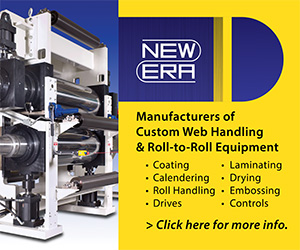Water-based adhesives meet just-in-time demands.
- Published: April 01, 1996, By Rolando, Thomas E.; Voss, Peter A.
High-performance, water-based adhesives cure in 24 to 48 hours, giving converters a competitive edge with their customers.
In this era of just-in-time (JIT) delivery, inventories have been dramatically reduced as a result of economic, environmental, and competitive pressures. The converting industry is no exception to the JIT way of doing business. Suppliers to the converting industry have been put to the test to develop new and innovative products that will not only meet converters' requirements for faster turnaround times but also meet tightening environmental regulations. One such development has been the introduction of fast-curing, water-based, dry-bond laminating adhesives.
Technological advances in the field of solvent-free, water-based polyurethane dispersions (PUDs) paired with uniquely compatible crosslinkers have allowed the development of such rapid-curing laminating adhesives. "High-performance" PUD adhesives have a cure time of 24 to 48 hours, compared to other commercially available PUD laminating systems that have full cure times of 7 to 21 days at room temperature.
The Solvent Way
In the past converters have used solvent-based, dry-bond laminating adhesives for virtually every application, from lower performance (snack food packaging) to medium performance (meat and cheese packaging) to high end (boil-in-bag packaging) to the many industrial and miscellaneous applications.
Typical two-part, solvent-based adhesive systems generally would take one to seven days before a full cure would take effect and impart the necessary heat, humidity, chemical, and tunneling resistance properties of the finished laminations. For most snack food applications, solvent-based adhesive systems would impart the necessary resistance properties in 24 to 48 hours.
Although the adhesive system must have enough green strength to allow the converter to further process the lamination (such as making another laminating pass, slitting, etc.), it also must possess the bond strength and resistance properties to allow the converter's customer to further process (such as form, fill, and seal) the lamination. Ultimately, a fully cured adhesive system will preserve the integrity of the finished package or lamination.
In general, the more demanding the end-use application, the longer the adhesive cure time needed. Ideally, solvent-based systems adequately meet the converter's performance requirements for JIT fast turnaround time. However, because of the many environmental restrictions governing the use of solvent-based materials, the converter has been forced to look at other alternatives.
The main options available to converters are water-based systems and 100% solids systems. Although meeting most of the converter's needs, 100% solids systems require a large capital expense to convert from solvent-based laminating equipment.
Water-based systems have much to offer. They can be readily used on the same dry-bond laminating equipment as the solvent-based materials after installation of a smoothing bar and with the use of pretreated or in-line corona treated films. Water-based systems are generally acrylic- or PUD-based. PUD adhesive systems have shown superior performance properties in the areas of clarity, machinability, and adhesion to many substrates.
Compared to alternate technologies, PUDs are very competitive on a performance-versus dry-bond cost basis. Until recently most water-based products (especially PUDs) have required at least 7 to 21 days at room temperature to properly cure out and impart the necessary properties to the final lamination - even in some snack food applications.
High-performance water-based PUDs, along with uniquely compatible crosslinkers, have 24-to 48-hour cure times, allowing the converter to be more competitive in the JIT business arena. Table 1 indicates the reaction cure times of two-component, high-performance PUDs versus other commercially available PUDs.
The high-performance PUD products, when cross-linked, have reaction cure times similar to or faster than other adhesive technologies. Table 2 compares typical required cure times to further process laminations made using two-component, water-based, solvent-based, and 100% solids adhesive systems.
Two-Component Systems
It should be noted that two-component systems are usually required on some snack food and virtually all medium-performance, high-performance, and industrial laminations. In general, any lamination requiring heat, humidity, or chemical resistance will usually require the use of a crosslinker with the base PUD. A crosslinker is also recommended for laminations prone to tunneling, which would involve laminating two films of differing extensibilities. Examples of such laminations include polyester to low-density polyethylene or oriented polypropylene to LDPE. The use of a crosslinker will aid in the prevention of tunneling. However, for high-performance PUDs, a crosslinker is not necessary for laminations involving films of similar extensibilities or when there are minimal heat and humidity resistance requirements. An example of this type of lamination is a typical snack food application involving a lamination of OPP to OPP.
Table 3 indicates green bond, slit time, and further processing time of one- and two-component, high-performance PUD systems.
High-performance PUD products offer a unique combination of excellent bond strengths and good resistance properties on a wide variety of laminations covering a broad range of applications. These systems impart excellent green strength properties and cure rates, enabling the converter to slit or further process laminations more rapidly.
Thomas E. Rolando and Peter A. Voss are senior chemists, Water Base I Lab, Hydroflex[R] Group, North American ASC Group. H.B. Fuller Co. Their chief responsibility is formulating adhesives for the flexible packaging industry. Both have degrees in chemistry and are members of TAPPI. They can be reached at 612/481-1895. Contributions to this article were made by Jim Keister, H.B. Fuller business development manager, paper and film converting. The authors would also like to thank Jon Wolfe, senior laboratory technician, and John Schommer, laboratory technician, for their work on this project.







